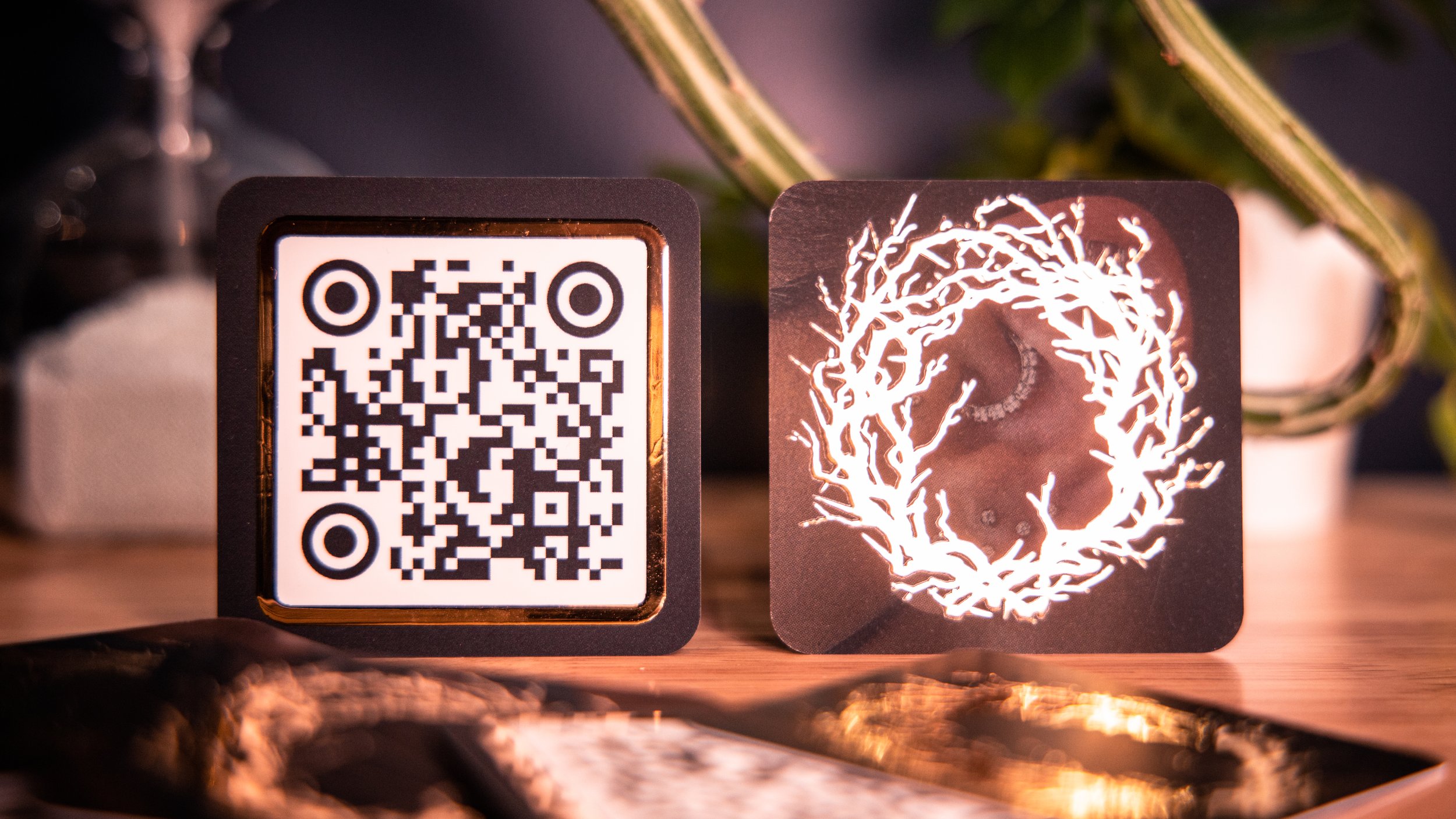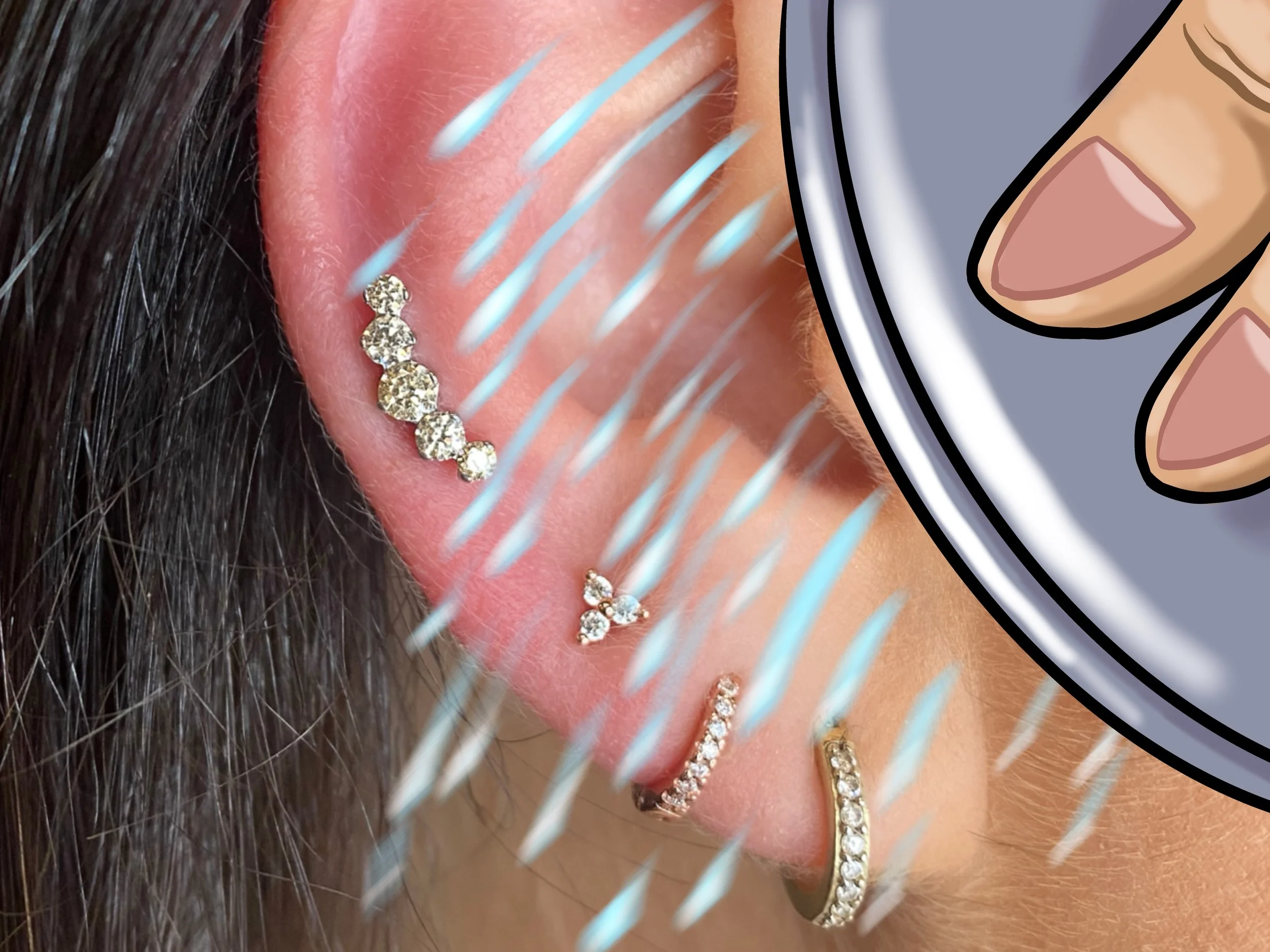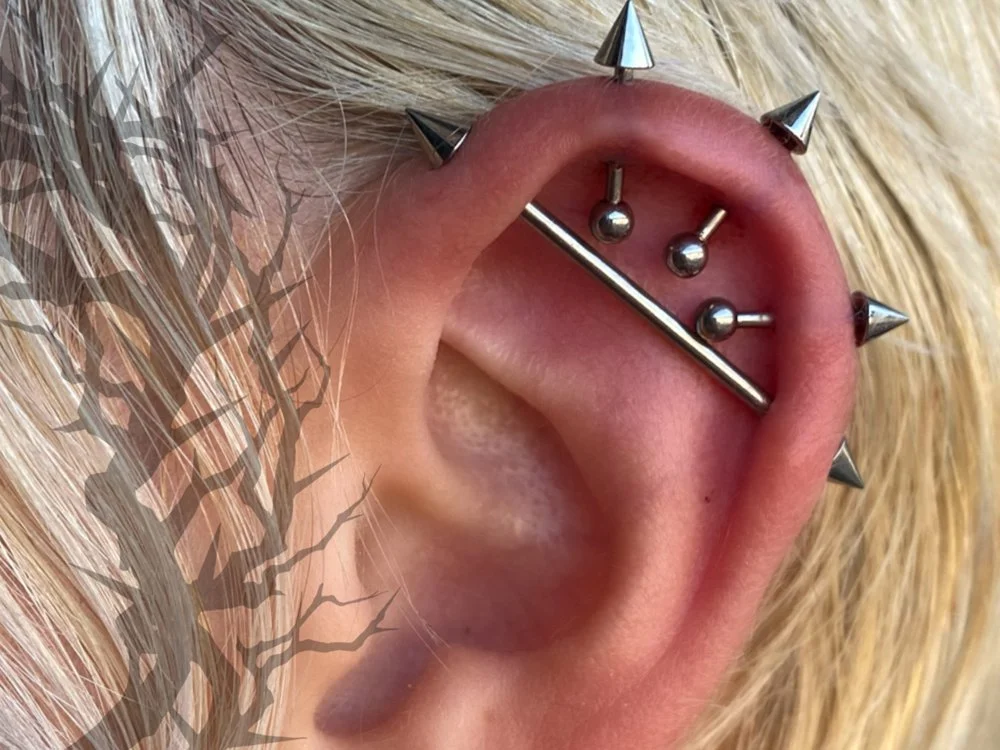
Piercing Aftercare
Rinse It
The easiest way to keep our piercing free of debris and squeaky clean is to incorporate your aftercare with your daily shower.
You start by performing your usual shower routine, avoiding your new piercings as best you can With any soaps. Once you are ready to get out of the shower, take a moment to allow your piercing to rinse under the running water for around 2 minutes. This will allow the piercing to irrigate correctly as well as rinse away or soften any debris or “crusties”
Dry It
Once your piercing is clean and any debris is softened, you need to dry your jewelry and skin using something disposable such as non-woven gauze, Q-tips or paper towel, sweeping away the soft debris from your skin and jewelry gently.
If a shower isn't possible, i recommend using a sterile saline spray instead Spray the piercing generously,allow the saline let it sit for a minute to allow the secretions to absorb enough fluid to become soft , spray again lightly to remoisten the area and then dry using something disposable such as non-woven gauze, Q-tips or paper towel, sweeping away the soft debris from your skin and jewelry gently. remember to not use fabric towels as these can leave tiny fibers as well as spread bacteria to your piercing site
Super Dry It
Once your piercing has been rinsed and dried, using a hairdryer on its cool setting to thoroughly dry the whole piercing site will remove any excess moisture and lower the risk for moisture-based irritations.
Downsizing
On the back of your card, you should have been given a downsize date, this means that enough time has passed for the irrigation stage of healing to be over, at this point your swelling should be gone and your piercing is ready to be switched to a more fitted piece which will allow for proper support, allowing your piercing to continue to heal correctly. Downsizing does not mean your piercing is healed so please avoid changing yourself at this stage.
Please get in touch around your downsize date, or when your swelling has subsided completely we are happy to check your progress and switch you out to a fitted piece if you are ready!
Sorry folks, this does not mean it's hoop time. Hoops must wait for their full healing cycle.
Remember!
Jewelry is not one size fits all, your sizing being correct is very important for your healing as well as long-term piercing health.
Things To Avoid
No touching. No touching, spinning or picking at your piercing. Your hands go through so much throughout the day, bacteria can easily be transferred to your piercing as well as unnecessary touching or spinning can severely damage your piercing channel, delaying the healing process. Taking your new piercing out for extended periods of time will increase your risk of closure - even after it is deemed “healed”.
-
No sleeping on your piercing or wearing anything on top of your piercing that applies pressure. One of the biggest issues for healing piercings is pressure, during healing any pressure can restrict blood flow and vital irrigation and can cause migration leading to the required removal of your piercings.
If you are a side sleeper, a travel pillow can help you sleep comfortably without risking your piercing. any exercise or activity that requires prolonged pressure to a piercing site should be avoided until your healed date. clothing and accessories should be comfortable and not pressing on the piercing site. -
Swelling, redness, dry skin- all these things are natural during the different healing stages. Trying piercing hacks you see on the internet will most likely lead to irritation, infection and possible irreparable damage to not only your piercing but to your jewelry too.
So please no tea tree oil, aspirin paste, antibacterial soap, salt water mixes, peroxide, polysporin, alcohol or contact lense solution. our bodies need very little to do their jobs effectively, a safe piercing experience, good quality jewelry, and a correct and consistent aftercare routine is all you need. for anything else, reach out to us!, we are here to help -
Swimming, tubing, lake trips and the ocean all should be avoided for the first 12 weeks. Natural water sources have their own ecosystems and tiny microorganisms and countless bacteria that live inside of it, and these things can enter your body through a healing piercing site, causing not only serious irritations and healing complications to your piercing, but also opening up your body to potentially dangerous infections.
Public pools, hot tubs and backyard pools have filtration systems and chemicals that help keep bacteria to a minimum, but these precautions are only effective for common bacteria, they have little effect for serious bacteria such as staph and MRSA. You should wait until your fully healed date on your aftercare card until you swim. -
I know, I know, the ring is super cute. But you know what isn't cute? The dreaded bump!
Bumps form when the natural healing process is interrupted, this could be from a wide range of things, touching, spinning, sleeping on your piercing, but one of the most common issues is changing to a ring too early.
Changing the shape of the wound part-way through is going to have complications, you should wait until your healed date before switching to a ring. it will be worth the wait,we promise!Once your piercing is healed, you may be tempted by mall kiosks and cheap body jewelry stores, as fun and cute as they may look, these items are usually made of unsafe and toxic materials, these materials damage not only your piercing channel , but also can cause rashes, piercing bumps and irritation, bleeding, embedding and even allergic reactions and Argyria.
Implant grade jewelry is safest for all piercings and all skin types and usually comes with a lifetime warranty against defects you deserve it!
-
More often than not, what many people think of as an infection or keloid, is actually the result of irritation. If your piercing is red, swollen around the opening, peeling, excreting white or yellow fluid, bleeding slightly, or seems to have a solid (not fluid-filled) bump around the jewelry, These are all signs that the piercing is subject to an irritation..
Some common causes of irritation are touching or playing with your piercing, over cleaning, wearing overly restrictive clothing (navels and nipples), applying pressure during sleeping or phone use (ear cartilage), chewing gum, grinding teeth, or playing with the jewelry (tongue piercings), or other actions or activities that bump, twist, pull at, or put undue pressure on your piercing. If your piercing is irritated, figure out what’s causing the problem.
Once the cause of the irritation is found and eliminated, all symptoms, including the bump will often disappear. -
If your new piercing is angled, the wound is likely to have more pressure on one side, which can result in a bump forming. Unfortunately this problem carries with it other complications. Angled piercings are more likely to suffer migration or rejection. Depending on the severity of the angle, the piercing may have to be retired.
-
Body jewelry isn’t one size fits all, each person has unique anatomy that requires a certain size. If your jewelry does not fit , pressure can cause irritation, pain and can even embed your jewelry into your tissue.
Your jewelry should be appropriately sized throughout different stages of healing. Initial jewelry is usually longer or a higher gauge for swelling and healing, which will need to be downsized once the first stage of healing is complete and all swelling has subsided.
It's important to keep in touch to ensure your jewelry is not only the correct size, but implant grade, internally threaded or threadless and safe for long term wear. -
Movement as well as touching/ playing/ spinning your piercing is bad for you. While you may need to touch it in order to clean it, you should be very gentle.
Hands should be cleaned thoroughly and you should rinse your piercing as gently as possible, keeping any movement to a minimum.
You should never twist, pull, push or grab at your jewelry. your hands can also harbor a lot of bacteria and should never be anywhere near your piercing unless it's time to clean. -
Putting makeup , lotions, perfumes or other chemicals on your piercing can cause plenty of irritation, these chemicals, although safe to be on your skin, are not suitable for the inside of your skin, you also run the risk of cross contaminating your products. you should avoid any products near any healing piercing for the duration of healing
-
The common misconception is that the more you clean, the faster/better your piercing will heal, this unfortunately is a myth. using harsh cleaners, cleaning too often or cleaning too roughly is worse than not cleaning your piercing at all, you should only be rinsing in the shower or with a sterile saline solution for when a shower isn't possible.
-
Tight clothing, hats, glasses and other items of clothing can rub and restrict blood flow to your new piercing. Try to keep your piercings free and clear of waistbands, drawstrings and tight rough fabrics. It's ideal to tell your piercer if you have to wear glasses, uniforms or any equipment or device that may interfere with your healing process, we will always do our best to give you the best placement to keep you comfortable
-
Do you sleep with pets? Appreciate doggy/kitty kisses after a long day? (us too) but our best friend's hair and saliva is very very bad for healing piercings.
Keep your pet away from your piercing to minimize snag risks, keep your sheets clean to avoid any dander entering your piercing site and no kisses near any healing piercing to protect you from infection! BTW tell your dog we said hi! -
Probably the most common problem for a healing piercing is pressure, and pressure is most commonly happening during our sleep cycles. Sleeping on your piercing can not only cause irritation and the dreaded bump, but it can completely change the angle of the piercing, causing problems with the way the jewelry sits and looks. You should never sleep on a healing piercing.
If you have trouble staying off of your new ear piercings during your sleep, a travel pillow can help! This will allow you to sleep on your side while your ear is suspended in the hole of the travel pillow. This will ensure a good night's sleep without risking your new piercing's health!




